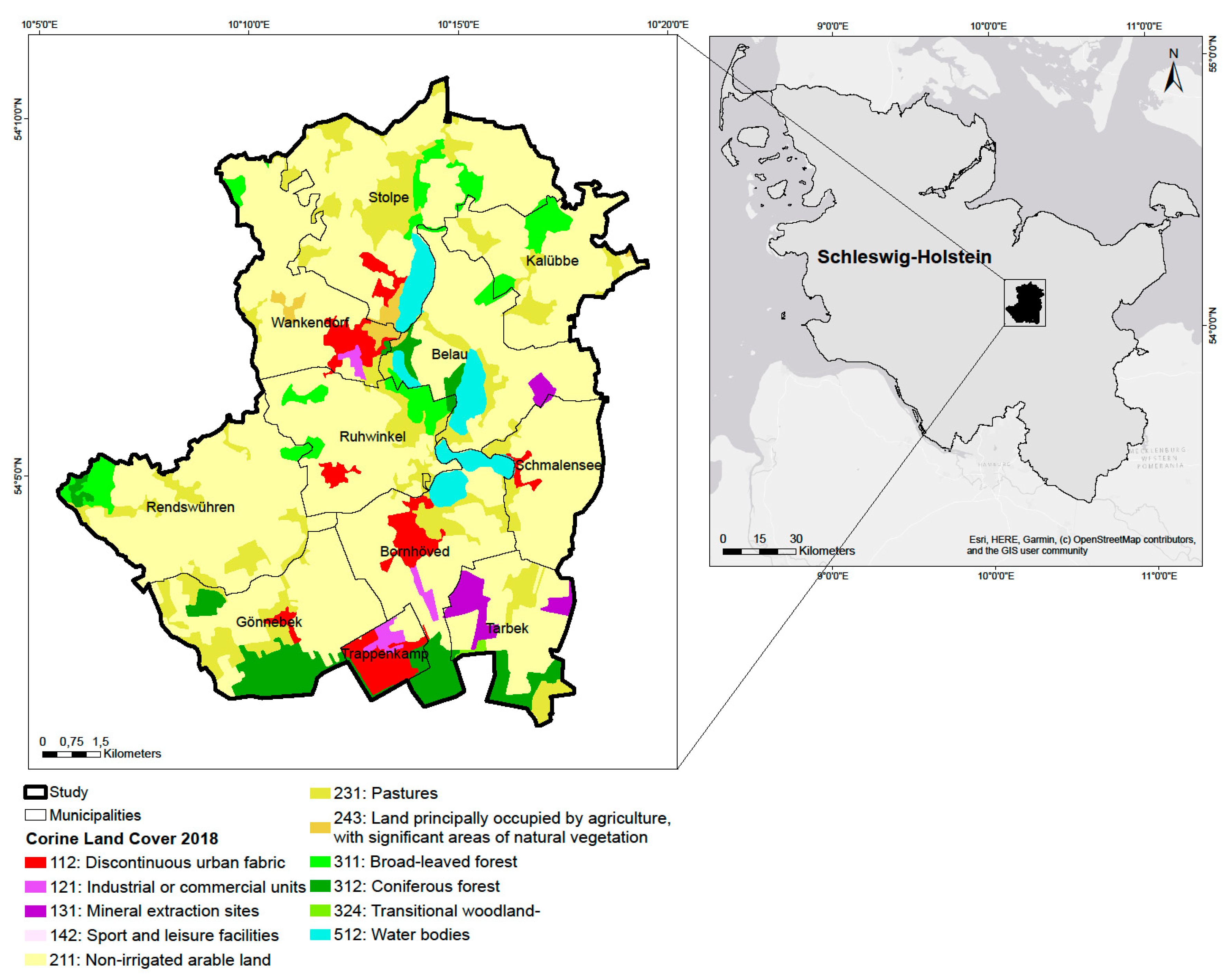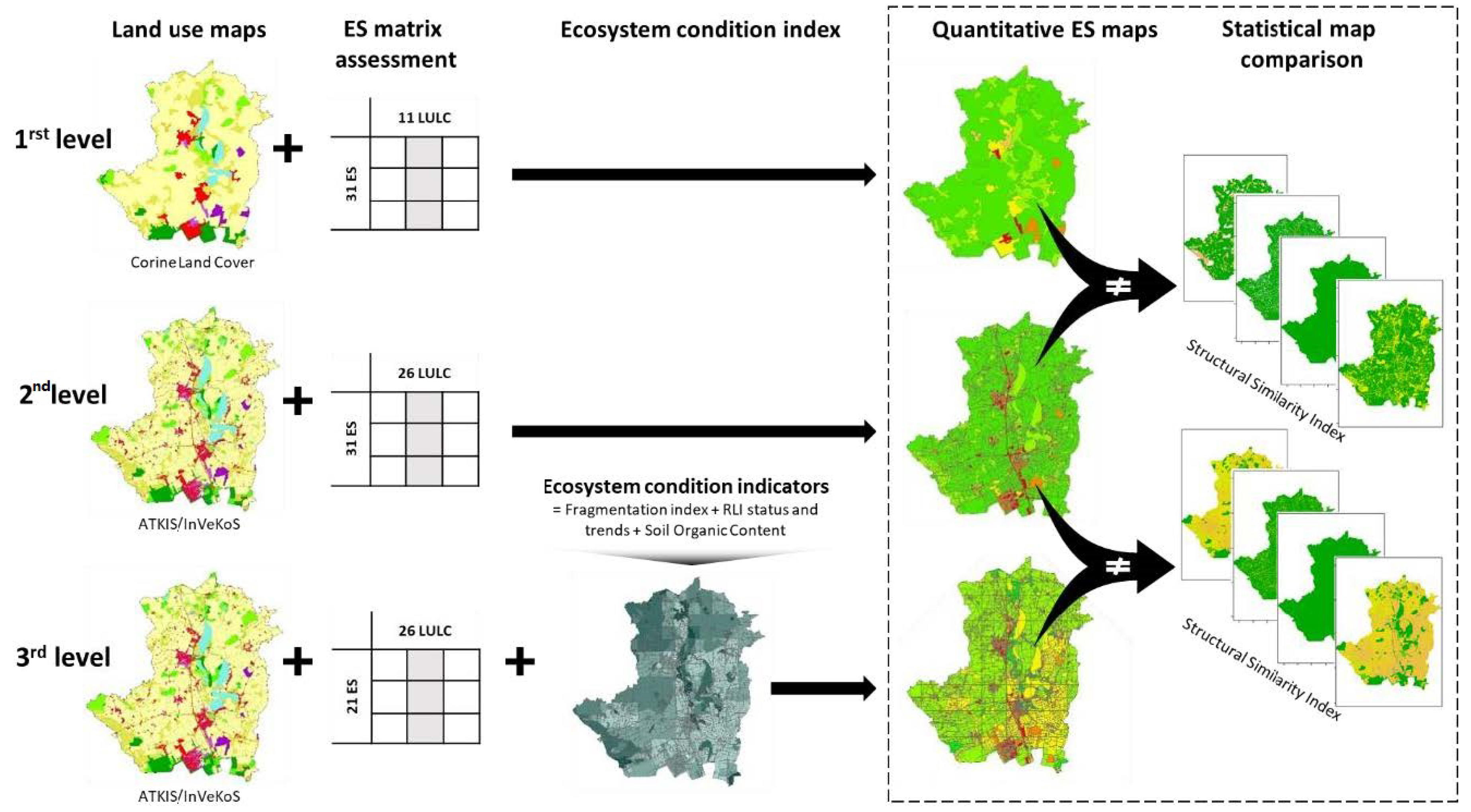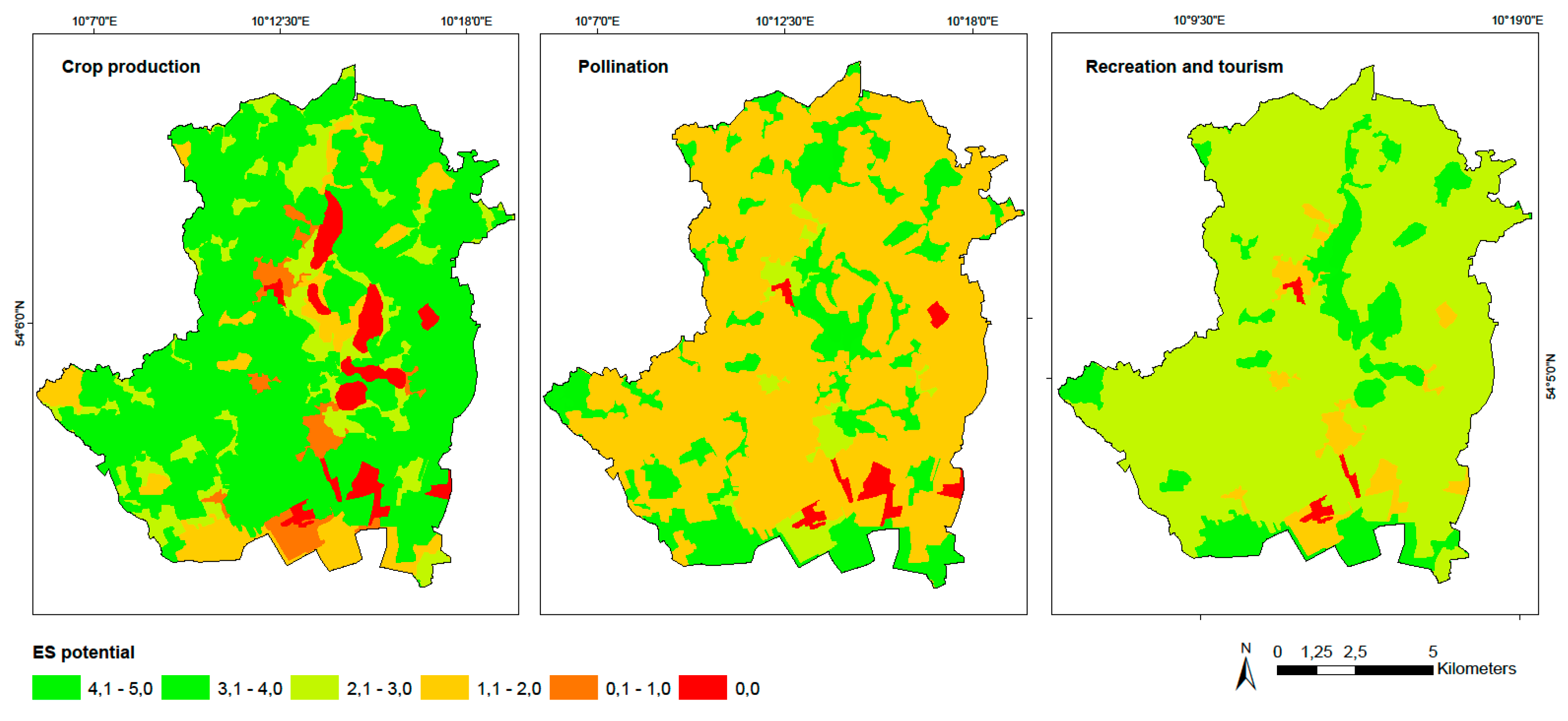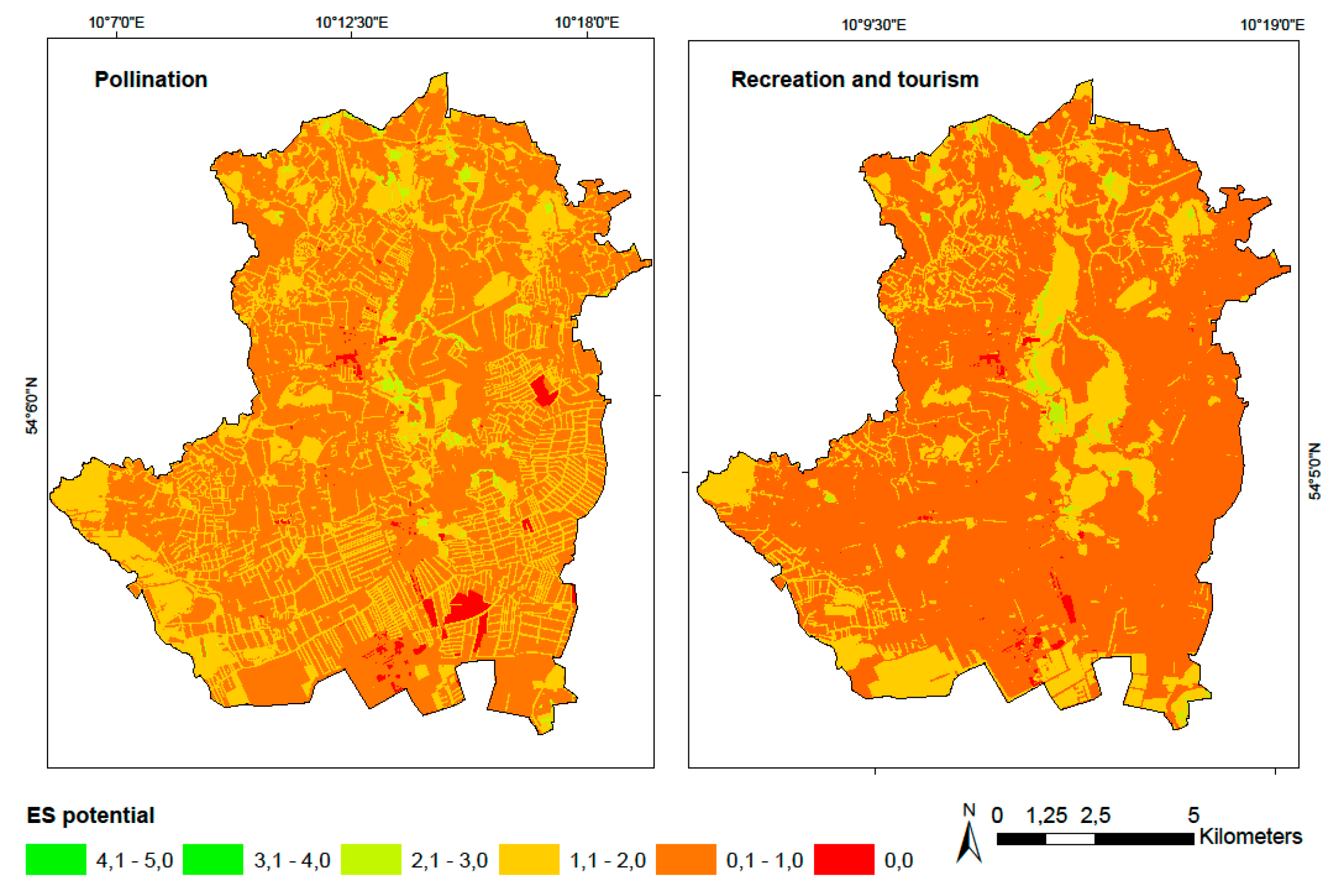Refining the Tiered Approach for Mapping and Assessing Ecosystem Services at the Local Scale: A Case Study in a Rural Landscape in Northern Germany
Abstract
:1. Introduction
- How does a higher spatial resolution with more information on small landscape elements affect the results of an ES-matrix assessment on a local scale?
- Does the integration of ecosystem condition information add value to the ES assessment and can patterns between different ES and ES categories be detected?
- What conclusions can be drawn for practical applications in landscape management?
2. Material and Methods
2.1. Case Study Area (CSA)
2.2. Ecosystem Services Assessments
2.2.1. Geospatial Datasets
2.2.2. ES Matrix Approach
2.2.3. Ecosystem Condition Indicators
Selecting Suitable Indicators
Landscape Fragmentation Index
Local Red List Index
Soil Organic Carbon (SOC)
2.3. ES Potential Maps
2.3.1. First and Second Level
2.3.2. Third Level
2.4. Influence of Typology and Resolution
2.5. Statistical Maps Comparison
3. Results
3.1. First Level Assessment
3.2. Second Level Assessment
3.3. Third Level Assessment
3.4. CORINE Land Cover and ATKIS/InVeKoS Typology Differences
3.5. Statistical Comparison of First and Second Level Assessment
3.6. Statistical Comparison Second and Third Level Assessment
4. Discussion
4.1. Discrepancies in ES Maps Based on Different Spatial Resolutions
4.2. Discrepancies in ES Maps Based on Different Data Complexity
4.3. Validation
4.4. Sources of Uncertainties of the Method
4.5. Suggestions for Improvement
4.5.1. Data Availability
4.5.2. Selecting Adapted Ecosystem Condition Indicators
5. Conclusions
Supplementary Materials
Author Contributions
Funding
Acknowledgments
Conflicts of Interest
Abbreviations
| Abbreviations | Definitions |
| ATKIS | Authoritative Topographic and Cartographic Information System |
| BGR | Federal Institute for Geosciences and Natural Resources |
| CBD | Convention for Biologic Diversity |
| CICES | Common International Classification of Ecosystem Services |
| CLC | CORINE land cover |
| CSA | Case study area |
| EC | Ecosystem condition |
| EEA | European Environment Agency |
| ES | Ecosystem service |
| EU | European Union |
| FISBo | Soil Information System of the Federal Geosciences and Natural Resources (BGR) |
| InVeKoS | Integrated administration and control system |
| LTER | Long-term ecological research |
| LULC | Land use/land cover |
| MES | Mapping and assessment of ecosystems and their services |
| MMU | Minimum mapping unit |
| RLI | Red List Index |
| SIM | Similarity in means |
| SIP | Similarity in pattern |
| SIV | Similarity in variance |
| SOC | Soil and organic carbon |
| SSIM | Structural similarity index |
References
- Millennium Ecosystem Assessment. Ecosystems and Human Well-Being: Biodiversity Synthesis; World Resources Institute: Washington, DC, USA, 2005. [Google Scholar]
- Maes, J.; Egoh, B.; Willemen, L.; Liquete, C.; Vihervaara, P.; Schägner, J.P.; Grizzetti, B.; Drakou, E.G.; La Notte, A.; Zulian, G.; et al. Mapping ecosystem services for policy support and decision making in the European Union. Ecosyst. Serv. 2012, 1, 31–39. [Google Scholar] [CrossRef]
- Hansen, R.; Pauleit, S. From multifunctionality to multiple ecosystem services? A conceptual framework for multifunctionality in green infrastructure planning for urban areas. AMBIO 2014, 43, 516–529. [Google Scholar] [CrossRef] [PubMed] [Green Version]
- De Groot, R.S.; Alkemade, R.; Braat, L.C.; Hein, L.; Willemen, L. Challenges in integrating the concept of ecosystem services and values in landscape planning, management and decision making. Ecol. Complex. 2010, 7, 260–272. [Google Scholar] [CrossRef]
- Martínez-Harms, M.J.; Balvanera, P. Methods for mapping ecosystem service supply: A review. Int. J. Biodivers. Sci. Ecosyst. Serv. Manag. 2012, 8, 17–25. [Google Scholar] [CrossRef]
- Grêt-Regamey, A.; Weibel, B.; Kienast, F.; Rabe, S.-E.; Zulian, G. A tiered approach for mapping ecosystem services. Ecosyst. Serv. 2015, 13, 16–27. [Google Scholar] [CrossRef]
- Burkhard, B.; Kroll, F.; Müller, F. Landscapes’ capacities to provide ecosystem services—A concept for land-cover based assessments. Landsc. Online 2009, 15, 1–22. [Google Scholar] [CrossRef]
- Burkhard, B.; Kroll, F.; Nedkov, S.; Müller, F. Mapping ecosystem service supply, demand and budgets. Ecol. Indic. 2012, 21, 17–29. [Google Scholar] [CrossRef]
- Burkhard, B.; Kandziora, M.; Hou, Y.; Müller, F. Ecosystem service potentials, flows and demands–concepts for spatial localisation, indication and quantification. Landsc. Online 2014, 34, 1–32. [Google Scholar] [CrossRef]
- Villamagna, A.M.; Angermeier, P.L.; Bennett, E.M. Capacity, pressure, demand, and flow: A conceptual framework for analyzing ecosystem service provision and delivery. Ecol. Complex. 2013, 15, 114–121. [Google Scholar] [CrossRef]
- Weibel, B.; Rabe, S.-E.; Burkhard, B.; Grêt-Regamey, A. On the importance of a broad stakeholder network for developing a credible, salient and legitimate tiered approach for assessing ecosystem services. One Ecosyst. 2018, 3, e25470. [Google Scholar] [CrossRef]
- Campagne, C.S.; Roche, P.K. May the matrix be with you! Guidelines for the application of expert-based matrix approach for ecosystem services assessment and mapping. One Ecosyst. 2017, 3, e24134. [Google Scholar] [CrossRef]
- Campagne, C.S.; Roche, P.; Müller, F.; Burkhard, B. Ten years of ecosystem services matrix: Review of a (r)evolution. One Ecosyst. 2020, 5, 106. [Google Scholar] [CrossRef]
- Jacobs, S.; Burkhard, B.; van Daele, T.; Staes, J.; Schneiders, A. ‘The Matrix Reloaded’: A review of expert knowledge use for mapping ecosystem services. Ecol. Model. 2015, 295, 21–30. [Google Scholar] [CrossRef]
- EEA. Corine Land Cover (CLC) 2018, Version 20b2. Available online: https://land.copernicus.eu/pan-european/corine-land-cover/clc2018 (accessed on 10 February 2020).
- Schröter, M.; Remme, R.P.; Sumarga, E.; Barton, D.N.; Hein, L. Lessons learned for spatial modelling of ecosystem services in support of ecosystem accounting. Ecosyst. Serv. 2015, 13, 64–69. [Google Scholar] [CrossRef]
- Bastian, O.; Haase, D.; Grunewald, K. Ecosystem properties, potentials and services–The EPPS conceptual framework and an urban application example. Ecol. Indic. 2012, 21, 7–16. [Google Scholar] [CrossRef]
- Balvanera, P.; Siddique, I.; Dee, L.; Paquette, A.; Isbell, F.; Gonzalez, A.; Byrnes, J.E.K.; O’Connor, M.I.; Hungate, B.A.; Griffin, J.N. Linking Biodiversity and Ecosystem Services: Current Uncertainties and the Necessary Next Steps. BioScience 2014, 64, 49–57. [Google Scholar] [CrossRef]
- Rendon, P.; Erhard, M.; Maes, J.; Burkhard, B. Analysis of trends in mapping and assessment of ecosystem condition in Europe. Ecosyst. People 2019, 15, 156–172. [Google Scholar] [CrossRef] [Green Version]
- Eigenbrod, F.; Armsworth, P.R.; Anderson, B.J.; Heinemeyer, A.; Gillings, S.; Roy, D.B.; Thomas, C.D.; Gaston, K.J. Error propagation associated with benefits transfer-based mapping of ecosystem services. Biol. Conserv. 2010, 143, 2487–2493. [Google Scholar] [CrossRef]
- Hou, Y.; Burkhard, B.; Müller, F. Uncertainties in landscape analysis and ecosystem service assessment. J. Environ. Manag. 2013, 127, 117–131. [Google Scholar] [CrossRef]
- van der Biest, K.; Vrebos, D.; Staes, J.; Boerema, A.; Bodí, M.B.; Fransen, E.; Meire, P. Evaluation of the accuracy of land-use based ecosystem service assessments for different thematic resolutions. J. Environ. Manag. 2015, 156, 41–51. [Google Scholar] [CrossRef]
- Schwartz, M.W.; Brigham, C.A.; Hoeksema, J.D.; Lyons, K.G.; Mills, M.H.; van Mantgem, P.J. Linking biodiversity to ecosystem function: Implications for conservation ecology. Oecologia 2000, 122, 297–305. [Google Scholar] [CrossRef] [PubMed]
- Haines-Young, R.H.; Potschin, M. The links between biodiversity, ecosystem services and human well-being. Ecosyst. Ecol. New Synth. 2010, 1, 110–139. [Google Scholar]
- Eigenbrod, F.; Armsworth, P.R.; Anderson, B.J.; Heinemeyer, A.; Gillings, S.; Roy, D.B.; Thomas, C.D.; Gaston, K.J. The impact of proxy-based methods on mapping the distribution of ecosystem services. J. Appl. Ecol. 2010, 47, 377–385. [Google Scholar] [CrossRef]
- Kandziora, M.; Burkhard, B.; Müller, F. Mapping provisioning ecosystem services at the local scale using data of varying spatial and temporal resolution. Ecosyst. Serv. 2013, 4, 47–59. [Google Scholar] [CrossRef]
- Ecosystem Organization of a Complex Landscape. Long-Term Research in the Bornhöved Lake District, Germany; Fränzle, O., Blume, H.-P., Dierssen, K., Kappen, L., Eds.; Springer: Berlin/Heidelberg, Germany, 2008; ISBN 978-3-540-75811-2. [Google Scholar]
- Bicking, S.; Burkhard, B.; Kruse, M.; Müller, F. Mapping of nutrient regulating ecosystem service supply and demand on different scales in Schleswig-Holstein, Germany. One Ecosyst. 2018, 3, e22509. [Google Scholar] [CrossRef] [Green Version]
- Bach, M.; Breuer, L.; Frede, H.-G.; Huisman, J.A.; Otte, A.; Waldhardt, R. Accuracy and congruency of three different digital land-use maps. Landsc. Urban Plan. 2006, 78, 289–299. [Google Scholar] [CrossRef]
- Burkhard, B.; Maes, J. 5.1. What to map? In Mapping Ecosystem Services; Syrbe, R.-U., Schröter, M., Grunewald, K., Walz, U., Burkhard, B., Eds.; Pensoft Publisher: Sofia, Bulgaria, 2017. [Google Scholar]
- Burkhard, B.; Maes, J. Mapping Ecosystem Services; Pensoft Publishers: Sofia, Bulgaria, 2017; ISBN 978-954-642-829-5. [Google Scholar]
- Haines-Young, R.; Potschin, M. Common International Classification of Ecosystem Services (CICES), Version 5.1. Guidance on the Application of the Revised Structure. 2018. Available online: https://cices.eu/content/uploads/sites/8/2018/01/Guidance-V51-01012018.pdf (accessed on 10 January 2020).
- Müller, F.; Bicking, S.; Ahrendt, K.; Bac, D.K.; Blindow, I.; Fürst, C.; Haase, P.; Kruse, M.; Kruse, T.; Ma, L. Assessing ecosystem service potentials to evaluate terrestrial, coastal and marine ecosystem types in Northern Germany–An expert-based matrix approach. Ecol. Indic. 2020, 112, 106116. [Google Scholar] [CrossRef]
- European Commission. Our Life Insurance, Our Natural Capital: An EU Biodiversity Strategy to 2020; European Commission: Belgium, Brussels, 2011; p. 244. [Google Scholar]
- Maes, J.; Teller, A.; Erhard, M.; Grizzetti, B.; Barredo, J.I.; Paracchini, M.; Condé, S.; Somma, F.; Orgiazzi, A.; Jones, A.; et al. Mapping and Assessment of Ecosystems and their Services: An Analytical Framework for Ecosystem Condition; Publications Office of the European Union: Luxembourg, 2018. [Google Scholar]
- EEA. Landscape Fragmentation in Europe. Joint EEA-FOEN Report. Literaturverz. S.69–76; European Environment Agency: Copenhagen, Denmark, 2011; ISBN 978-92-9213-215-6. [Google Scholar]
- Fahrig, L.; Rytwinski, T. Effects of roads on animal abundance: An empirical review and synthesis. Ecol. Soc. 2009, 14, 21. [Google Scholar] [CrossRef]
- Mitchell, M.G.E.; Suarez-Castro, A.F.; Martinez-Harms, M.; Maron, M.; McAlpine, C.; Gaston, K.J.; Johansen, K.; Rhodes, J.R. Reframing landscape fragmentation’s effects on ecosystem services. Trends Ecol. Evol. 2015, 30, 190–198. [Google Scholar] [CrossRef] [Green Version]
- Vié, J.-C.; Hilton-Taylor, C.; Pollock, C.; Ragle, J.; Smart, J.; Stuart, S.N.; Tong, R. The IUCN Red List: A Key Conservation Tool. Wildlife in a Changing World–An Analysis of the 2008 IUCN Red List of Threatened Species; IUC: Gland, Switzerland, 2009; p. 1. [Google Scholar]
- Butchart, S.H.M.; Akçakaya, H.R.; Chanson, J.; Baillie, J.E.M.; Collen, B.; Quader, S.; Turner, W.R.; Amin, R.; Stuart, S.N.; Hilton-Taylor, C. Improvements to the red list index. PLoS ONE 2007, 2, e140. [Google Scholar] [CrossRef]
- Klinge, A. Die Amphibien und Reptilien Schleswig-Holsteins-Rote Liste, 3. Fassung, Dezember 2003; LANU: Flintbek, Germany, 2003; ISBN 3-923339-93-3. [Google Scholar]
- Knief, W.; Berndt, R.K.; Hälterlein, B.; Jeromin, K.; Kieckbucsh, J.J.; Koop, B. Die Brutvögel Schleswig-Holsteins-Rote Liste, 5. Fassung-Oktober 2010; LANU: Flintbek, Germany, 2010; ISBN 3-937937-45-8. [Google Scholar]
- Borkenhagen, P.; Drews, A. Die Säugetiere Schleswig-Holsteins-Rote Liste, 4. Fassung, (Datenstand: November 2013); Ministerium für Energiewende Landwirtschaft Umwelt und Ländliche Räume des Landes Schleswig-Holstein (MELUR): Kiel, Germany, 2014; ISBN 978-3-937937-76-2.
- Juslén, A.; Pykälä, J.; Kuusela, S.; Kaila, L.; Kullberg, J.; Mattila, J.; Muona, J.; Saari, S.; Cardoso, P. Application of the Red List Index as an indicator of habitat change. Biodivers. Conserv. 2016, 25, 569–585. [Google Scholar] [CrossRef] [Green Version]
- Daily, G.C. Nature’s services. In Societal Dependence on Natural Ecosystems; Island Press: Washington, DC, USA, 1997; ISBN 1-55963-475-8. [Google Scholar]
- Swinton, S.M.; Lupi, F.; Robertson, G.P.; Landis, D.A. Ecosystem Services from Agriculture: Looking Beyond the Usual Suspects. Am. J. Agric. Econ. 2006, 88, 1160–1166. [Google Scholar] [CrossRef]
- Hewitt, A.; Dominati, E.; Webb, T.; Cuthill, T. Soil natural capital quantification by the stock adequacy method. Geoderma 2015, 241, 107–114. [Google Scholar] [CrossRef] [Green Version]
- Adhikari, K.; Hartemink, A.E. Linking soils to ecosystem services—A global review. Geoderma 2016, 262, 101–111. [Google Scholar] [CrossRef]
- Drobnik, T.; Greiner, L.; Keller, A.; Grêt-Regamey, A. Soil quality indicators – From soil functions to ecosystem services. Ecol. Indic. 2018, 94, 151–169. [Google Scholar] [CrossRef]
- Baveye, P.C.; Baveye, J.; Gowdy, J. Soil “Ecosystem” services and natural capital: Critical appraisal of research on uncertain ground. Front. Environ. Sci. 2016, 4, 609. [Google Scholar] [CrossRef]
- Düwel, O.; Siebner, C.S.; Utermann, J.; Krone, F. Gehalte an Organischer Substanz in Oberböden Deutschlands Bericht über länderübergreifende Auswertungen von Punktinformationen im FISBo BGR; Bundesanstalt für Geowissenschaften und Rohstoffe: Hannover, Germany, 2007. [Google Scholar]
- Mordhorst, A.; Fleige, H.; Zimmermann, I.; Burbaum, B.; Filipinski, M.; Cordsen, E.; Horn, R. Organische Kohlenstoffvorräte von Bodentypen in den Hauptnaturräumen Schleswig-Holsteins (Norddeutschland). Die Bodenkult. J. Land Manag. Food Environ. 2018, 69, 85–95. [Google Scholar] [CrossRef] [Green Version]
- Spangenberg, J.H.; Görg, C.; Truong, D.T.; Tekken, V.; Bustamante, J.V.; Settele, J. Provision of ecosystem services is determined by human agency, not ecosystem functions. four case studies. Int. J. Biodivers. Sci. Ecosyst. Serv. Manag. 2014, 10, 40–53. [Google Scholar] [CrossRef] [Green Version]
- Balvanera, P.; Pfisterer, A.B.; Buchmann, N.; He, J.-S.; Nakashizuka, T.; Raffaelli, D.; Schmid, B. Quantifying the evidence for biodiversity effects on ecosystem functioning and services. Ecol. Lett. 2006, 9, 1146–1156. [Google Scholar] [CrossRef] [Green Version]
- Harrison, P.A.; Berry, P.M.; Simpson, G.; Haslett, J.R.; Blicharska, M.; Bucur, M.; Dunford, R.; Egoh, B.; Garcia-Llorente, M.; Geamănă, N. Linkages between biodiversity attributes and ecosystem services: A systematic review. Ecosyst. Serv. 2014, 9, 191–203. [Google Scholar] [CrossRef] [Green Version]
- Jones, E.L.; Rendell, L.; Pirotta, E.; Long, J.A. Novel application of a quantitative spatial comparison tool to species distribution data. Ecol. Indic. 2016, 70, 67–76. [Google Scholar] [CrossRef]
- R Core Team. A Language and Environment for Statistical Computing; R Foundation for Statistical Computing: Vienna, Austria, 2017. [Google Scholar]
- Rioux, J.-F.; Cimon-Morin, J.; Pellerin, S.; Alard, D.; Poulin, M. How land cover spatial resolution affects mapping of urban ecosystem service flows. Front. Environ. Sci. 2019, 7, 345. [Google Scholar] [CrossRef]
- Schulp, C.J.E.; Alkemade, R. Consequences of uncertainty in global-scale land cover maps for mapping ecosystem functions: An analysis of pollination efficiency. Remote Sens. 2011, 3, 2057–2075. [Google Scholar] [CrossRef] [Green Version]
- Lavorel, S.; Bayer, A.; Bondeau, A.; Lautenbach, S.; Ruiz-Frau, A.; Schulp, N.; Seppelt, R.; Verburg, P.; van Teeffelen, A.; Vannier, C.; et al. Pathways to bridge the biophysical realism gap in ecosystem services mapping approaches. Ecol. Indic. 2017, 74, 241–260. [Google Scholar] [CrossRef] [Green Version]
- Sinclair, M.; Mayer, M.; Woltering, M.; Ghermandi, A. Using social media to estimate visitor provenance and patterns of recreation in Germany’s national parks. J. Environ. Manag. 2020, 263, 110418. [Google Scholar] [CrossRef]
- Chabert, A.; Sarthou, J.-P. Conservation agriculture as a promising trade-off between conventional and organic agriculture in bundling ecosystem services. Agric. Ecosyst. Environ. 2020, 292, 106815. [Google Scholar] [CrossRef]
- Zulian, G.; Stange, E.; Woods, H.; Carvalho, L.; Dick, J.; Andrews, C.; Baró, F.; Vizcaino, P.; Barton, D.N.; Nowel, M.; et al. Practical application of spatial ecosystem service models to aid decision support. Ecosyst. Serv. 2018, 29, 465–480. [Google Scholar] [CrossRef]
- Schulp, C.J.E.; Burkhard, B.; Maes, J.; van Vliet, J.; Verburg, P.H. Uncertainties in ecosystem service maps: A comparison on the European scale. PLoS ONE 2014, 9, e109643. [Google Scholar] [CrossRef] [Green Version]
- Díaz, S.; Fargione, J.; Chapin, F.S.; Tilman, D. Biodiversity loss threatens human well-being. PLoS Biol. 2006, 4, e277. [Google Scholar] [CrossRef] [Green Version]
- de Groot, R.S. Integrating the ecological and economic dimensions in biodiversity and ecosystem service valuation. In The Economics of Ecosystems and Biodiversity: The Ecological and Economic Foundations; TEEB: London, UK, 2010; Volume 40, pp. 10–15. [Google Scholar] [CrossRef]
- van Oudenhoven, A.P.E.; Petz, K.; Alkemade, R.; Hein, L.; de Groot, R.S. Framework for systematic indicator selection to assess effects of land management on ecosystem services. Ecol. Indic. 2012, 21, 110–122. [Google Scholar] [CrossRef]
- Kandziora, M.; Burkhard, B.; Müller, F. Interactions of ecosystem properties, ecosystem integrity and ecosystem service indicators—A theoretical matrix exercise. Ecol. Indic. 2013, 28, 54–78. [Google Scholar] [CrossRef]
- Braat, L.C.; Brink, P. The Cost of Policy Inaction. The Case of Not Meeting the 2010 Biodiversity Target; Report to the European Commission under Contract: Brussels, Belgium, 2008. [Google Scholar]
- Cardinale, B.J.; Duffy, J.E.; Gonzalez, A.; Hooper, D.U.; Perrings, C.; Venail, P.; Narwani, A.; Mace, G.M.; Tilman, D.; Wardle, D.A.; et al. Biodiversity loss and its impact on humanity. Nature 2012, 486, 59–67. [Google Scholar] [CrossRef] [PubMed]
- Roche, P.K.; Campagne, C.S. Are expert-based ecosystem services scores related to biophysical quantitative estimates? Ecol. Indic. 2019, 106, 105421. [Google Scholar] [CrossRef]








| CLC Level 2 | CLC Level 3 Classes | Corresponding ATKIS/InVeKoS Classes | % Total ATKIS/InVeKoS | % Total CLC Level 3 |
|---|---|---|---|---|
| Arable land | Non–irrigated arable land | Arable land | 59.81% | 67.25% |
| Fallow land | 0.36% | |||
| Truck farm | 0.48% | |||
| Permanent crops | Fruit trees and berry plantations | Fruit trees and berry plantations | 0.02% | |
| Pastures | Pastures | Pastures | 11.76% | 13.12% |
| Heterogeneous agricultural areas | Land principally occupied by agriculture, with significant areas of natural vegetation | – | 0.84% | |
| – | Hedgerows | 2.36% | ||
| – | Tree rows | 0.21% | ||
| – | Copse, thickets | 0.15% | ||
| – | Single trees | 0.08% | ||
| – | Field borders | 0.11% | ||
| Forests | Broad–leaved forest | Broad–leaved forest | 3.34% | 4.22% |
| Coniferous forest | Coniferous forest | 3.85% | 4.95% | |
| Mixed forest | Mixed forest | 3.48% | ||
| Scrub and/or herbaceous vegetation associations | Transitional woodland–shrub | – | 0.10% | |
| Sclerophyllous vegetation | Sclerophyllous vegetation | 0.33% | ||
| Open spaces with little or no vegetation | Sparsely vegetated areas | Sparsely vegetated areas | 0.17% | |
| Urban fabric | Continuous housing area | Continuous housing area | 3.15% | |
| Discontinuous urban fabric | Discontinuous housing area | 1.65% | 4.32% | |
| Industrial, commercial and transport units | Industrial or commercial units | Industrial and commercial units | 0.99% | 0.72% |
| Airports | Airports | < 0.01% | ||
| Road and rail network | Rail network | 0.09% | ||
| Road network | 2.32% | |||
| Mine, dump and construction sites | Mineral extraction sites | Mineral extraction sites | 0.89% | 1.41% |
| – | Paths | 0.52% | ||
| Artificial, non-agricultural vegetated areas | Sport and leisure facilities | Sport and leisure facilities | 0.61% | < 0.01% |
| Inland waters | Water courses | Water courses | 0.08% | |
| Water bodies | Water bodies | 3.70% | 3.07% | |
| – | Ditch | 0.35% | ||
| Inland wetlands | Inland marshes | Wetlands | 0.08% |
| Indicators | References | Spatial Resolution | |
|---|---|---|---|
| Ecosystem attributes | Landscape fragmentation index | EEA landscape fragmentation per km (mesh) | 1 km2 |
| Red List Index for ecosystems | Schleswig–Holstein Red Lists and ATKIS/InVeKoS LULC classes | Variable (from +/- 3 m to less than 1 ha as ATKIS and InVeKoS resolution) | |
| Structural soil attributes | Soil organic carbon (SOC) | Federal Institute for Geosciences and Natural Resources (BGR) | 0.25 km2 |
© 2020 by the authors. Licensee MDPI, Basel, Switzerland. This article is an open access article distributed under the terms and conditions of the Creative Commons Attribution (CC BY) license (http://creativecommons.org/licenses/by/4.0/).
Share and Cite
Perennes, M.; Campagne, C.S.; Müller, F.; Roche, P.; Burkhard, B. Refining the Tiered Approach for Mapping and Assessing Ecosystem Services at the Local Scale: A Case Study in a Rural Landscape in Northern Germany. Land 2020, 9, 348. https://doi.org/10.3390/land9100348
Perennes M, Campagne CS, Müller F, Roche P, Burkhard B. Refining the Tiered Approach for Mapping and Assessing Ecosystem Services at the Local Scale: A Case Study in a Rural Landscape in Northern Germany. Land. 2020; 9(10):348. https://doi.org/10.3390/land9100348
Chicago/Turabian StylePerennes, Marie, C. Sylvie Campagne, Felix Müller, Philip Roche, and Benjamin Burkhard. 2020. "Refining the Tiered Approach for Mapping and Assessing Ecosystem Services at the Local Scale: A Case Study in a Rural Landscape in Northern Germany" Land 9, no. 10: 348. https://doi.org/10.3390/land9100348






